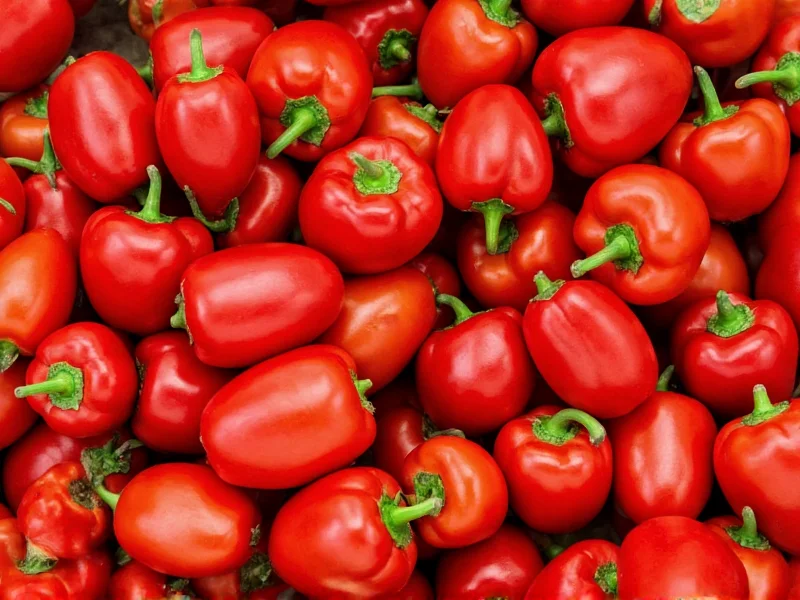Understanding what paprika is made of reveals the fascinating journey from farm to spice rack. This vibrant red powder has become a staple in kitchens worldwide, but its composition and production process remain a mystery to many home cooks and food enthusiasts. Let's explore the botanical origins, processing methods, and variations that define this versatile spice.
The Botanical Foundation of Paprika
Paprika's story begins with specific varieties of peppers belonging to the Capsicum annuum species. Unlike cayenne or other hot chili powders that often use Capsicum frutescens, paprika primarily utilizes sweeter pepper varieties. The most common peppers used include:
- Bell peppers (zero Scoville heat units)
- Ári椒 (Hungarian wax peppers)
- Deglet Noor peppers
- Kalifornia Reaper (for smoked varieties)
- Various specialty cultivars developed specifically for paprika production
The exact pepper varieties used determine paprika's final characteristics. For instance, Hungarian paprika often uses Komáromi and Fehérőtövis peppers, while Spanish paprika frequently incorporates Ónácha peppers that contribute to its distinctive smoky flavor.
From Pepper to Powder: The Production Process
Creating authentic paprika involves several precise steps that preserve flavor compounds and vibrant color:
- Cultivation: Peppers are grown in optimal conditions with attention to soil composition and climate
- Harvesting: Peppers are picked at peak ripeness when capsaicin and carotenoid levels are highest
- Drying: Traditional methods involve air-drying peppers on strings or in special drying rooms
- Processing: Stems and seeds are removed before grinding (though some varieties retain seeds for heat)
- Grinding: Dried peppers are milled to specific particle sizes depending on the intended use
- Storage: Properly stored in airtight containers away from light to preserve flavor and color
Traditional paprika production, particularly in Hungary's Kalocsa and Szeged regions, often involves smoking peppers over oak or beech wood, creating the distinctive flavor profile of smoked paprika. This process differs significantly from standard chili powder production, which typically uses hotter peppers and may include additional spices.
| Type of Paprika | Primary Pepper Source | Heat Level (Scoville) | Distinctive Characteristics |
|---|---|---|---|
| Sweet Hungarian | Komáromi, Fehérőtövis | 0-150 SHU | Bright red, sweet flavor, floral notes |
| Smoked Spanish (Pimentón) | Ónácha, Jeromín | 100-500 SHU | Deep mahogany, smoky flavor, complex notes |
| Hot Hungarian | Esztergom, Édesnemes | 5,000-15,000 SHU | Vibrant red, noticeable heat, balanced flavor |
| American Standard | Mixed bell peppers | 0-500 SHU | Lighter red, mild flavor, often blended with other spices |
Chemical Composition: What's Really in Paprika
Beyond just ground peppers, paprika contains several key compounds that contribute to its properties:
- Carotenoids (5-10%): Primarily capsanthin and capsorubin, responsible for the vibrant red color
- Essential oils (0.5-1.5%): Including capsaicin (0-1.5%), which determines heat level
- Vitamin C (140-250mg/100g): Higher than fresh peppers due to concentration during drying
- Vitamin E (8-15mg/100g): Natural antioxidant properties
- Flavonoids: Contributing to flavor complexity and health benefits
The precise composition varies significantly based on pepper variety, growing conditions, and processing methods. For example, smoked paprika contains additional phenolic compounds from the smoking process that contribute to its distinctive flavor profile and extended shelf life.
Common Misconceptions About Paprika Composition
Several myths persist about what paprika is made from:
- Myth: Paprika is made from tomatoes or other nightshades besides peppers
Fact: Paprika comes exclusively from specific pepper varieties, never from tomatoes - Myth: All paprika contains added coloring agents
Fact: Authentic paprika gets its color naturally from carotenoids in the peppers - Myth: Paprika is just another name for generic chili powder
Fact: While both are ground peppers, paprika specifically refers to milder varieties with distinctive production methods - Myth: Paprika always contains preservatives
Fact: Pure paprika requires no preservatives when properly dried and stored
How to Identify Authentic Paprika
When purchasing paprika, understanding what it's made of helps identify quality products:
- Check the ingredient list: Authentic paprika should list only "dried ground peppers" or similar
- Observe the color: High-quality paprika has a deep, vibrant red hue without orange or brown tones
- Smell the spice: Should have a fresh, pepper-forward aroma without mustiness
- Consider the origin: Traditional regions like Hungary, Spain, and California produce distinctive varieties
Be wary of products listing "spice blend" or containing additives like silicon dioxide, which indicate lower quality or diluted product. Pure paprika made from quality peppers requires no additional ingredients.
Practical Applications of Paprika Knowledge
Understanding what paprika is made from helps in several practical ways:
- Culinary substitutions: Knowing pepper varieties helps find appropriate substitutes when specific paprika types aren't available
- Storage optimization: Understanding the chemical composition explains why paprika should be stored in dark, cool places to preserve carotenoids
- Recipe success: Selecting the right paprika type based on its composition improves dish outcomes
- Health considerations: Awareness of capsaicin content helps those sensitive to heat choose appropriate varieties
Whether you're exploring traditional Hungarian goulash, Spanish paella, or simply adding color to deviled eggs, understanding paprika's composition enhances your cooking experience and results.











 浙公网安备
33010002000092号
浙公网安备
33010002000092号 浙B2-20120091-4
浙B2-20120091-4